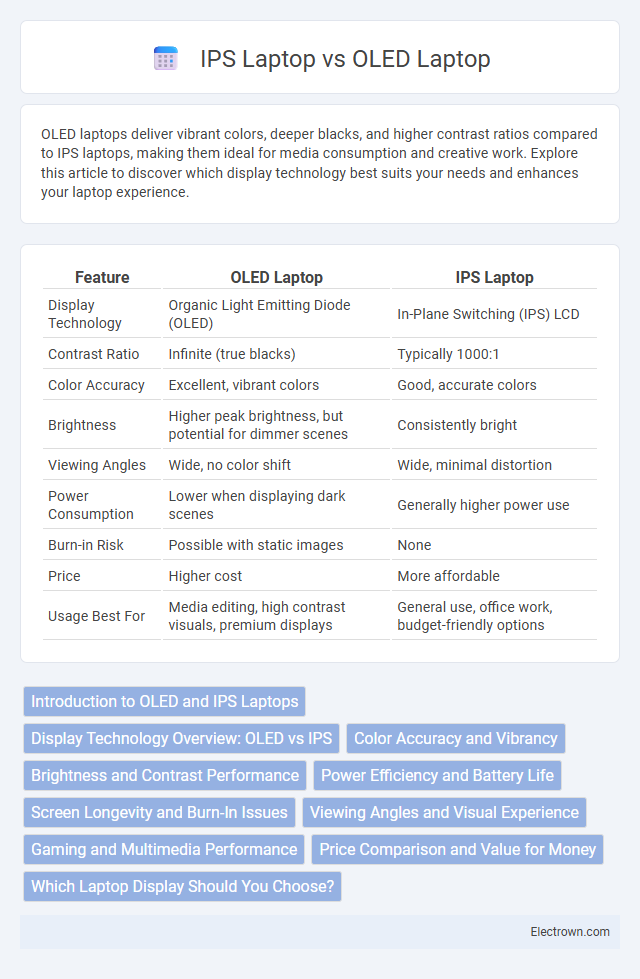OLED laptops deliver vibrant colors, deeper blacks, and higher contrast ratios compared to IPS laptops, making them ideal for media consumption and creative work. Explore this article to discover which display technology best suits your needs and enhances your laptop experience.
Table of Comparison
| Feature | OLED Laptop | IPS Laptop |
|---|---|---|
| Display Technology | Organic Light Emitting Diode (OLED) | In-Plane Switching (IPS) LCD |
| Contrast Ratio | Infinite (true blacks) | Typically 1000:1 |
| Color Accuracy | Excellent, vibrant colors | Good, accurate colors |
| Brightness | Higher peak brightness, but potential for dimmer scenes | Consistently bright |
| Viewing Angles | Wide, no color shift | Wide, minimal distortion |
| Power Consumption | Lower when displaying dark scenes | Generally higher power use |
| Burn-in Risk | Possible with static images | None |
| Price | Higher cost | More affordable |
| Usage Best For | Media editing, high contrast visuals, premium displays | General use, office work, budget-friendly options |
Introduction to OLED and IPS Laptops
OLED laptops feature organic light-emitting diode displays that offer superior contrast, deeper blacks, and more vibrant colors compared to traditional panel types. IPS laptops use in-plane switching technology, providing wider viewing angles and consistent color accuracy, making them ideal for professional work. Your choice between OLED and IPS depends on whether you prioritize visual depth and color richness or color consistency and viewing flexibility.
Display Technology Overview: OLED vs IPS
OLED laptops feature organic light-emitting diodes that produce individual pixels emitting their own light, delivering deeper blacks, higher contrast ratios, and more vibrant colors compared to IPS displays. IPS laptops utilize liquid crystal technology with consistent backlighting, offering wide viewing angles and accurate color reproduction but generally lower contrast and brightness levels than OLED panels. Choosing between OLED and IPS displays impacts your laptop experience in terms of color accuracy, battery life, and visual quality, with OLED excelling in dynamic visuals and IPS favored for color consistency and power efficiency.
Color Accuracy and Vibrancy
OLED laptops deliver superior color accuracy and vibrancy compared to IPS laptops due to their self-emissive pixels that produce deeper blacks and more saturated colors. IPS panels offer good color reproduction and wide viewing angles but typically lack the same level of contrast and luminance as OLED screens. Your choice between OLED and IPS should consider whether you prioritize unparalleled color precision and dynamic visuals for tasks like photo editing or prefer balanced performance with longer battery life.
Brightness and Contrast Performance
OLED laptops deliver superior brightness and contrast performance with self-emissive pixels that produce deeper blacks and more vibrant colors compared to IPS laptops. IPS displays, while offering consistent brightness and wide viewing angles, typically cannot match the infinite contrast ratios and rich color accuracy found in OLED panels. Your choice should consider OLED's exceptional contrast for multimedia and creative work against IPS's reliable brightness in well-lit environments.
Power Efficiency and Battery Life
OLED laptops consume less power compared to IPS laptops by selectively lighting individual pixels, which reduces overall energy usage and extends battery life, especially when displaying darker images or themes. IPS laptops require the entire backlight to be on at all times, leading to higher power consumption and shorter battery duration under similar usage conditions. If maximizing Your laptop's battery longevity is a priority, choosing an OLED screen offers a more power-efficient solution.
Screen Longevity and Burn-In Issues
OLED laptops offer superior contrast and vibrant colors but are more susceptible to burn-in and image retention over time, which can affect screen longevity. IPS laptops provide more stable screen performance with minimal risk of burn-in, ensuring longer-lasting display quality under regular usage conditions. Users seeking durability and consistent performance often prefer IPS panels to avoid the potential degradation issues associated with OLED technology.
Viewing Angles and Visual Experience
OLED laptops deliver superior viewing angles with consistent color accuracy and brightness, ensuring vivid visuals from nearly any perspective. IPS laptops offer wide viewing angles but often experience slight color and contrast shifts when viewed off-center. The advanced pixel technology in OLED panels provides deeper blacks and higher contrast ratios, resulting in a more immersive and vibrant visual experience compared to IPS displays.
Gaming and Multimedia Performance
OLED laptops deliver superior gaming and multimedia performance with vibrant colors, deeper blacks, and faster response times compared to IPS laptops. The high contrast ratio and wider color gamut of OLED displays enhance visual immersion, while their lower latency benefits fast-paced gaming. IPS laptops offer consistent brightness and color accuracy but generally lack the dynamic range and speed required for the most demanding gaming and multimedia experiences.
Price Comparison and Value for Money
OLED laptops typically command a higher price than IPS laptops due to their superior color accuracy, deeper blacks, and enhanced contrast ratios. While IPS laptops offer good image quality at a more affordable cost, OLED displays provide a notably richer visual experience that justifies the premium for users valuing display performance. You can achieve better value for money by choosing an IPS laptop if budget constraints dominate, but OLED laptops deliver unparalleled picture quality that appeals to professionals and enthusiasts.
Which Laptop Display Should You Choose?
OLED laptops offer superior contrast ratios, vibrant colors, and deeper blacks, making them ideal for users prioritizing media consumption and creative work. IPS laptops provide accurate color reproduction and wider viewing angles at a lower cost, which suits professionals needing color consistency and budget-conscious buyers. Choosing between OLED and IPS depends on your preference for visual quality versus affordability and battery efficiency.
OLED Laptop vs IPS Laptop Infographic

 electrown.com
electrown.com